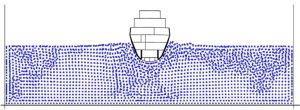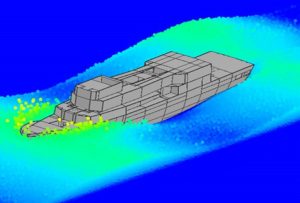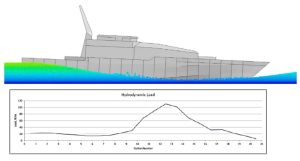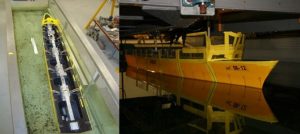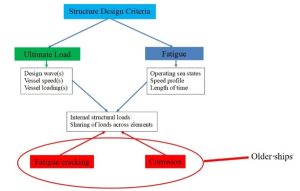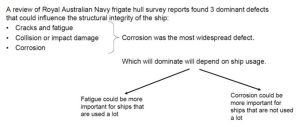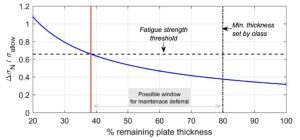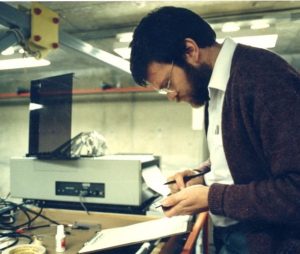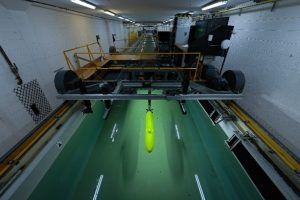Technical Presentation –– 3 July 2024
Martin Renilson, Adjunct Professor at AMC/UTas, gave a presentation on Structural Integrity and Safety of Older Ships in a Seaway to a meeting at the Australian Maritime College in Launceston, Zoomed to Taylor Bros in Derwent Park, Hobart, and streamed live to the wider fraternity on 14 May. The presentation was attended by 10 in Launceston, 5 in Hobart, and a further 15 participating online.
Older ships can suffer from corrosion which results in wastage of hull plating and stiffeners, hence reducing their strength and increasing the possibility of failure when encountering severe waves. Maintenance is expensive, and the costs of “over maintaining” can be prohibitive. On the other hand, if corrosion in critical areas in the ship are not repaired in a timely manner, then the resulting failure caused by the stresses when operating in a seaway can be catastrophic.
It is therefore important to understand how any corrosion influences the residual strength of the ship, and the consequent stresses in structural members as the ship encounters waves.
This presentation discussed how smoothed-particle hydrodynamics (SPH) can be used together with finite-element analysis (FEA) to study the stresses in the ship as it encounters waves. t is felt that this approach can lead to a reduction in maintenance costs and ensuring that aging ships can be operated safely beyond their originally-planned lifetimes.
Cross section showing how the SPH particles are maintained in the tank
and outside of the ship, by a “contact interface”
(Diagram courtesy Bruce Cartwright)
Numerical simulation of a ship in waves using SPH
(Diagram courtesy Bruce Cartwright)
The hydrodynamic loading is used to predict
both the global motions and the structural response of the ship
(Diagram courtesy Bruce Cartwright)
Prediction of loading on the ship as a function of longitudinal position
(Diagram courtesy Bruce Cartwright)
The numerical predictions were validated against published results
obtained using a segmented model
(Photos from Reference 1)
Structural design criteria were developed for both ultimate load, and fatigue;
older ships suffer from fatigue cracking and corrosion, reducing their strength
(Diagram courtesy Bruce Cartwright)
Dominant defects from a RAN frigate hull survey
(Diagram courtesy Bruce Cartwright)
Using the hydrodynamic loading the local structural loading can be predicted. The stress as a function of the percentage of remaining plate thickness can be obtained. Hence, it is possible to determine whether maintenance is required, or can be deferred
Charts indicating stress magnification as a function of plate thickness, as shown above, can be used by capability managers to understand:
- relative criticality of structural defects;
- relative risks of deferring defect rectification; and
- how such defects will influence life extension.
This may result in considerable cost saving, and increased ship availability, whilst ensuring adequate safety.
References
- Morris, B., Hutchison, C., Thomas, G., Phelps, B. and Lilienthal, T., (2010), Hydroelastic Response of a Segmented Frigate Model, Proceedings Pacific International Maritime Conference, Sydney, Australia, 2010.
- Cartwright, B., Renilson, M., McGuckin, D., Magoga, T., Mulcahey, L., Melchers, R. and Chor, A. (2022), Towards a Cost-effective Approach to Extending the Life of Naval Surface Ships, Proceedings Indo Pacific 2022 International Maritime Conference, Sydney, Australia.
The presentation was not recorded.
The Presenter
Martin Renilson graduated from the University of Glasgow with a BSc degree in naval architecture. He moved to Tasmania in 1983 to work at the Australian Maritime College, where he established the Ship Hydrodynamics Centre in 1985, and the Department of Naval Architecture and Ocean Engineering in 1996, with the first naval architecture and then ocean engineering degrees at AMC.
In 2001 he moved to the UK to work at QinetiQ as Technical Manager, Maritime Platforms and Equipment. In this role he was responsible for all hydrodynamic research for the UK Ministry of Defence.
In 2007 he returned to Australia where he now has a position as Adjunct Professor at AMC/UTas.
He has recently been involved in a research project on the numerical modelling of ship response under corrosion, fatigue and complex sea-state environments which was funded by the Australian Research Council.
Martin Renilson
Technical Presentation –– 9 July 2024
Gregor Macfarlane, Associate Professor, and Thomas Rehrmann, Engineer, Australian Maritime College/Utas, gave a presentation on The AMC Towing Tank: Four Decades Solving Hydrodynamic Problems for the Maritime Industry to a meeting at the Australian Maritime College in Launceston, Zoomed to the Royal Yacht Club of Tasmania in Hobart, and streamed live to the wider fraternity on 9 July. The presentation was attended by 14 in Launceston, 3 in Hobart, and a further 24 participating online.
The presentation began with Gregor giving a brief history of towing tanks in general, with the first tank built in 1872 by William Froude on his own land in Torquay, England. This was followed by the first tank built for a commercial shipbuilder, William Denny & Brothers, in Dumbarton, Scotland. In recent years this tank was utilised by the University of Strathclyde, but is now part of the Scottish Maritime Museum. It was noted that the presenter performed experiments in this tank while on sabbatical in the late 1990s, while living 17 miles away at a fourth-generation family business on Loch Lomond: Macfarlane & Son Boatyard in Balmaha.
The AMC Towing Tank was built in the basement of AMC’s Swanson Building in 1980, but it took the arrival of Dr Martin Renilson in 1983 before key equipment like the carriage and wavemaker started to be commissioned. The first laboratory sessions for students and commercial consultancies both took place around 1984. By the 1990s the tank was in heavy demand, particularly by academic and industry participants within the Australian Maritime Engineering Cooperative Research Centre (whose HQ was at based at AMC).
It is claimed that this tank performed scale model experiments on more catamarans than any other tank internationally, reflecting the successes of many Australian naval architects and shipbuilders of the time. This success, and the growing need to test models of high-speed craft, provided the support required to secure funding to extend the tank length from 60 to 100 m in 2005. Also of note was the development of the complementary shallow-water wave basin in 2000–01, with dimensions of 35 m long 12 m wide, in contrast to the tank of 100 m × 3.5 m × 1.5 m deep.
The importance of manufacturing bespoke scale models and test rigs which are appropriate for high-fidelity hydrodynamics experiments was communicated. It was noted that these specialist capabilities were developed continuously over the life of the towing tank, but particularly over the past 15 years as the demand for more-complex and geometrically-accurate models increased, mainly through Defence research contracts. According to facility records, in excess of 860 models have been tank tested over the past four decades. A large number of selected models have been retained in a secure store at AMC.
Gone are the days when the most-common experiments performed in the AMC tank are simple calm-water resistance tests to predict the powering required for a new design or modification to an existing hull. These experiments accounted for almost 50% of the consultancy projects undertaken during the first decade of the AMC facility’s operation. The past two decades has seen a gradual but clear shift towards much more complex experiments—often to provide vital support in validating numerical techniques such as potential-flow codes and computational fluid dynamic (CFD) models. Simple “bread and butter” calm-water resistance experiment now only occupy about 5% of the available time in AMC’s heavily-utilised towing tank and shallow-water wave basin.
Some background on each of the following three clientele categories were presented:
- Education and training
- Research
- Commercial consultancies
Each year, approximately 12 different laboratory sessions are run by facility staff, predominantly for those students enrolled in AMC’s naval architecture and maritime engineering degrees, but also for seafarers. Over the life of the facilities, many BEng students have taken advantage of the opportunity of using the tank and basin as part of their capstone research project in their final year. To highlight this, a scrolling list of ~470 different student project titles which involved such experiments was presented, many of which also involved industry participation.
AMC’s continuous support for the training of naval architects enrolled at other Australian academic institutions was noted, especially UNSW Sydney and, more recently, UNSW Canberra (ADFA).
Due to time constraints, only a very brief description of one recent PhD research project was presented as an example of the novel types of research performed in the tank. AMC have used the relatively small size of this facility to benefit by undertaking novel and unusual experiments which are often too challenging and expensive to do in larger facilities. Gregor indicated that further details on some example projects are available in the paper which he presented at Indo Pacific IMC in 2017.
To highlight the large number and variety of commercial clients which the team running these facilities have serviced since 1984, a scrolling list of over 200 companies and organisation who had used the tank and basin was presented.
Gregor finished his part of the presentation by describing the importance of being proactively involved in the International Towing Tank Conference (ITTC), which is the peak body for maritime hydrodynamics, where one of their many roles is to develop the recommended procedures for carrying out physical model experiments and numerical modelling of ships and marine installations. Given our geographical remoteness, involvement with the ITTC has provided many AMC staff with extremely valuable experience and professional development. It is believed that AMC’s contributions to the ITTC has been relatively high for a small institution, which partly led to AMC securing the right to host the next full ITTC conference in Tasmania in September this year.
Gregor then handed over to Thomas Rehrmann who presented details of recent enhancements to the towing tank and new capabilities developed. Specific examples included a new state-of-the-art wave generator and inertial properties measurement system, both commissioned in 2023. The new electrically-driven wavemaker consists of six individual dry-back paddles which enables better controllability by using force feedback (hydrostatic pressure exists on just one side of the paddles, unlike the old wet-backed paddle). The new wavemaker comes with significantly advanced control software, which permits remote operation which will assist the AMC team to achieve their goal of being able to remotely operate the whole towing tank operation, including carriage motion, data acquisition, wavemaker operation and video recording. Experiments performed in the shallow-water basin at AMC can already be automatically/remotely operated.
The inertial properties measurement system, alternatively termed a ‘shaker table’, measures inertial properties of rigid objects of almost any size and shape having a mass up to approximately 500 kg. It consists of a platform constrained from underneath by soft coil springs and supported at its centre by five degree-of-freedom air bearing mechanisms. Sensors measure the platform’s free vibration following excitation. The rigid-body properties are obtained by fitting a numerical model to the free vibration signals.
This capability means that there is no longer a requirement to reposition a model to quantify or adjust its mass properties for each individual axis, as has been done for the past forty years using traditional methods, as all axes can now be determined from a single setup. Not only does this save considerable time, but it can provide significantly more accurate measurements by avoiding the many errors which can accumulate from having to set up the model for each axis of interest separately, and adjust for changes in LCG/TCG after each adjustment of mass position(s). This equipment is particularly suited to models/objects of odd shape which are difficult to support in multiple-axis orientations, such as a yacht with a bulbous keel.
Other recent enhancements include an improved design of conventional two-post dynamometer; new water filtration system, commissioning of an array of self-calibrating non-contact wave probes; and several improvements of the carriage, such as a revamp of the carriage layout, refined speed control, and progress towards its remote operation.
Dr Martin Renilson onboard the AMC Towing Tank carriage circa 1990, prior to digital data acquisition systems
Note the paper chart recorder, calculator, clipboard and liquid paper
(Photo courtesy Gregor Macfarlane)
The AMC Towing Tank with a scale model of a generic BB2 submarine
mounted fully submerged at mid-water depth beneath the carriage
(Photo courtesy Gregor Macfarlane)
The Presenters
Dr Gregor Macfarlane is an Associate Professor in Maritime Hydrodynamics at the Australian Maritime College, a specialist institute of the University of Tasmania. He is a naval architect with 30 years’ experience in experimental techniques applied to engineering hydrodynamic problems. Water waves are a central theme to his work: quantifying waves created by moving boats and ships; how ocean waves affect the motions and loads of ships and offshore structures; and extracting renewable energy from ocean waves.
Thomas Rehrmann is a local Launcestonian and has a passion for the maritime industry, having spent much of his free time boating and fishing around the state of Tasmania. After graduating with a bachelor’s degree in naval architecture from the Australian Maritime College, he took up a full-time role as an engineer with the hydrodynamic testing facilities—the towing tank and the model test basin—where his duties for a two-year period were focused on research capability enhancement. He is now employed by the Autonomous Maritime Systems department at AMC, servicing and operating autonomous underwater vehicles.
Richard Boult

